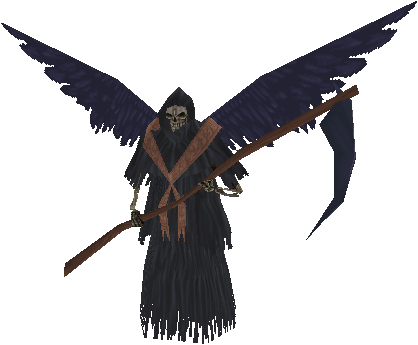


How can he be neutral if he wants to end everything? This has then gone on to color many other depictions of Death (most of them unfavorable), giving us the villain we know now. As one of the four horsemen (joined by his pals War, Famine, and Pestilence, the three of which who have yet to show up in the Castlevania series), Death is supposed to bring on Armageddon, which has certainly put a pall over his perception among the masses. Not that Castlevania is the only place to truly consider Death evil. That doesn't prevent him from trying, time and again, a companion-coyote to Dracula's own Wile E. Of course, in continuity, Death is never successful at this pursuit (which certainly shows that while Death might want to take an active hand, even he cannot resist the machinations of Fate). He's the right-hand man of Dracula, a willing servant who battles the Belmonts (and other heroes) in an attempt to reap their souls early, sending them straight to Hell. In Castlevania, though, Death is very evil. But Death himself isn't normally viewed as evil: death is a natural occurrence and Death himself is simply a figure embodying that function. In dark times, such as great famines or when plagues were spreading across the land, the figure of Death would be considered quite scary, sweeping across the land, scythe in hand, as he reaps whole fields of souls. Known in pop culture as "the Grim Reaper", traditionally Death is seen as an anthropomorphic figure, the shadowy skeleton cloaked in tatters who comes to collect the souls of the dead and usher them into the afterlife. "What, Death isn't in this game? How strange!"
CASTLEVANIA ANIME GRIM REAPER SERIES
Death is indelible to the series at this point that it's more noticeable when he doesn't appear then when he does. While Belmonts come and go, Death has been a constant presence in the series, showing up (arguably) in more games than even Dracula himself (in the main series, Death only misses out on three titles: The Castlevania Adventure, its direct sequel Castlevania II: Belmont's Revenge, and the arcade spin-off of the series Haunted Castle). Dracula, Lord of Darkness, is truly one of the most powerful entities across the decades of Castlevania.If there is any other character aside from Dracula it would be Death. Finally, in Dracula X Chronicles, after defeating his second form, he introduces a third and even more powerful dark-angel form not seen in the original Rondo of Blood. Meanwhile, several modes in Circle of the Moon make him incredibly difficult to fight, such as Thief. The SNES rendition of Rondo of Blood, known as Dracula X, featured a Dracula battle atop multiple pitfalls. Struggling players would be doomed before entering the boss room while R.Count was immune to the Valmanway, one of the game's strongest weapons for Alucard and Soma.ĭracula is oftentimes one of the hardest bosses in the game. Speaking of the retro Count, the R.Count enemy in Harmony of Despair could send fireballs across the entire stage. Beginning with the original Castlevania, as with Death, players lacking Holy Water or Cross (III) were doomed upon facing the Count's final form. The final boss fights of most entries in the series are naturally some of the hardest.


 0 kommentar(er)
0 kommentar(er)
